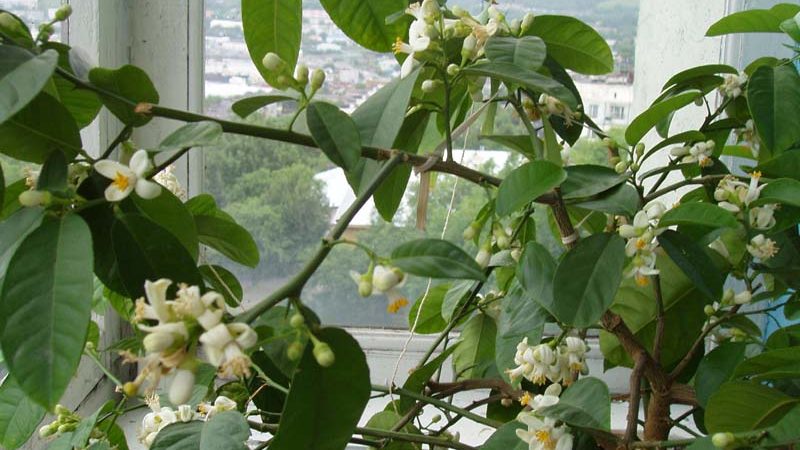How and when does lemon bloom at home?
Lemon essential oil has a beneficial effect on the nervous system, improves mood and disinfects the air in the room. Therefore, the tree is often grown as a houseplant.
It pleases its owners with beautiful flowering and healthy fruits, but only with proper care. Let's consider how and when lemon blooms at home, what are the features of care during this period.
When does lemon bloom at home?

When homemade lemon blooms depends on the growing method:
- From the seed - after about 6-8 years.
- By grafting a seedling with a branch from a fruit-bearing bush - in the second year after grafting.
- Cuttings from a fruiting plant - in the first year of life.
Also, a lot depends on the correct pinching and formation of the plant. Citrus fruits in the form of a bush bloom earlier, while citrus fruits bloom several years later.
Reference. The plant blooms in April – May.
How homemade lemon blooms
The flowering of a lemon tree consists of several successive stages:
- Laying flower stalks.
- Formation of single or paired buds on the peduncle.
- Opening of buds.
- Flowering lasts 7-9 days, after which the petals fall off.
- Formation of the ovary.
Citrus plants flower stalks in the axils of the leaves. The flowers are medium-sized, 2-3 cm in size. They look like vaguely toothed cups with 5 oval-shaped petals, strongly bent. White or cream inside, pink or purple outside. They are distinguished by a subtle delicate aroma.
Reference. In total, the period from the beginning of budding to the opening of the flower takes about 1.5 months.
Caring for indoor lemon
When caring for indoor lemons, it is important to adhere to seasonality. The periods can be divided into spring-summer and autumn-winter. If the frequency is not observed difficult to achieve flowering and fruiting.
Before and during flowering
Active growth begins in the spring with increasing daylight hours and continues throughout the summer. The plant is gaining strength and preparing to bloom.
At this time he needs:
- Temperature +20…+25°С.
- Plentiful lighting, but without direct sunlight. After winter, there is a high probability of leaf burn.
- Daylight hours are at least 12 hours.
- Influx of fresh air. The room is ventilated, but without allowing drafts. You can take the tree out onto the balcony or terrace, or into the garden.
- Regular spraying.
- Increase in quantity watering. When leaving the winter hut they do this gradually.
- Application of complex mineral fertilizers.
- Transfer in early spring. The fact that a larger pot is needed is indicated by wilting of the plant, drying out of the coma too quickly land after watering, the root system grows (roots appear in the holes at the bottom of the pot).
During flowering, it is necessary to especially carefully monitor the conditions of the lemon:
- Temperature – +18…+20°С. As temperatures rise, the tree will drop its flowers.
- Watering abundantly with settled water. Do not allow the earthen ball to dry out.
- Humidity – not lower than 70%.
- Lighting – abundant diffused sunlight.
- Thinning - leave large buds on the peduncles, tear off the rest.
- Fertilizing - potassium fertilizers are suitable.
One flowering is not enough for fruit to set.To do this, you need to pollinate yourself: use a cotton swab to transfer pollen from one flower to another. The method does not guarantee high-quality pollination, but it helps if there are no other options.
Reference. When choosing indoor lemons, it is better to give preference to self-pollinating varieties.
After flowering
After flowering, the lemon tree becomes more demanding of care, because it spends a lot of energy on growing and ripening the fruits.
Reference. The ripening period for lemons ranges from several months to a year.
When leaving, it is important to follow several rules:
- Regular abundant watering with water at room temperature. To preserve the ovaries, the plant is watered as the top layer of soil dries.
- Feeding. Mineral fertilizers based on nitrogen, phosphorus, and humate are needed, otherwise the fruits will dry out and fall off ahead of time, the skin will form too dense, and the shape of the fruit itself will be incorrect.
- Lighting. The best option is diffused sunlight.
- Sufficient air humidity. It is necessary to regularly spray the tree with a spray bottle.
- No drafts. You cannot leave it near an open window or vent. Air movement causes the ovaries to fall off.
- Temperature regime. During fruiting – +20…+25°С.
During fruit ripening, the plant should not be rotated or moved. If it is disturbed, it can cause the lemons to fall off.
After fruiting, the active season ends. After harvesting, the plant is prepared for wintering.
Care during this period comes down to following the rules:
- Washing leaves from dust.
- Trimming dry branches and leaves.
- Providing temperature within +14…+16°С. A cool winter is an important condition for the formation of flower stalks in the spring.
- Gradual reduction in the amount of watering.In winter, moisten with settled water at room temperature only when the top layer of soil has dried at least 2-3 cm.
- Avoid spraying.
- Stop feeding.
It is not worthwhile to add additional lighting to the tree due to the shortening of daylight hours in winter. Lemon does not suffer from a lack of light during this period.
Conclusion
Lemon is a citrus plant that is often grown at home. If you create the right conditions and care for it, it will delight you with the fruits.
For a lemon tree to bloom, it is extremely important to ensure temperature conditions, regular watering, plenty of light, high humidity, and fertilizing. Proper wintering, ensuring a low temperature, plays an important role in the establishment of flower stalks.